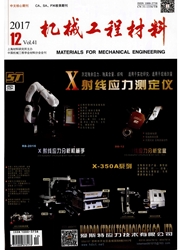

 中文摘要:
中文摘要:
d通过高温拉伸试验研究了应变速率对Cr15Mn9Cu2NiN和Crl7Mn6Ni4Cu2N两种铸态奥氏体不锈钢热塑性的影响。结果表明:Crl5Mn9Cu2NiN钢的显微组织为单一奥氏体,而Cr17Mn6Ni4Cu2N钢中有残留6铁素体分布在奥氏体晶界和晶粒内部;将应变速率由0.1S-1升高至10s-1后,变形时奥氏体晶界处增加的应力集中的作用与减少晶界滑移的作用相抵消,因此对Crl5Mn9Cu2NiN钢的热塑性无明显影响;但Crl7Mn6Ni4Cu2N钢的显微组织中存在较多的奥氏体/铁素体相界。这些相界在高应变速率时会变成位错源迅速产生大量的位错,从而提高奥氏体和铁素体强度,降低铁素体处的应力集中作用,使其断面收缩率提高10%以上。
 英文摘要:
英文摘要:
The influence of strain rate on the hot ductility of two kinds of cast austenitic stainless steels, Crl 5Mn9Cu2NiN and CrlTMn6Ni4Cu2N, has been studied in high temperature tensile tests. Results show that the microstructure of Crl5Mn9Cu2NiN steel was fully austenite, but residual i~ ferrites distributed in the boundaries and inside of austenite grains in CrlTMn6Ni4Cu2N steel. There was little influence on the hot ductility of CrlSMngCu2NiN steel as increasing strain rate from 0. 1 s-1 to 10 s-1, because the increased stress concentration on grain boundary was eliminated by the reducing of grain boundary sliding when increasing the strain rate. In the microstructure of Crl7Mn6Ni4Cu2N steel there was lots of interface between austenite and ferrite phase which generated dislocations as the materials deformed at higher strain rate, improving the strength of austenite and ferrite, then decreasing the stress concentration on ferrite, so the reduction of area was increased by more than 10%.
 同期刊论文项目
同期刊论文项目
 同项目期刊论文
同项目期刊论文
 期刊信息
期刊信息
